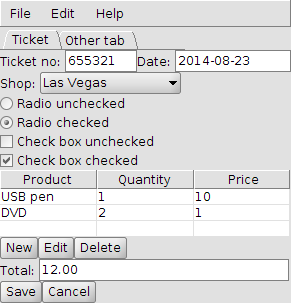Salt9000 is parser of the Salt language used by PlantUML and a translator to PNG using real Swing widgets.
Salt9000 is a parser build with an ANTLR grammar able to parse, a subset at the moment, of the Salt language, a PlantUML extension used to define UI from a textual definition.
You can use Salt9000 in several ways:
- use it as a stand-alone parser in your applications.
- write your own visitor (or listener) using
SaltTextVisitororSaltSwingVisitoras a base. - use the
SaltSwingVisitorto transform a text-based UI definition to set ofJFrame,JPanel,JTextField, etc. - use the command line interface to render a text-based UI definition to a PNG file with your preferred Swing Look&Feel.
If you want to improve Salt9000:
- the Compile Salt9000 launch configuration let you generate default parser, lexer, listener and visitor from
the
Salt.g4grammar file.
The following are still missing because this is the very first version and I don't need them at the moment:
- separators (.., ==, ~~, --).
- vertical tabs.
- creole syntax: probably I won't never need it and for the integration with PlantUML this part is not required.
- cell spans.
- OpenIconic icons.
- vertical opened menus.
- clone the project.
- import it into eclipse.
From here you can:
- run the test suite: run the class
SaltTestfrom eclipse as JUnit test. - run grun Salt9000 launch configuration and visualize parsing result on the console for the
examples/grun.s9file. - run SaltCLI launch configuration and obtain the PNG file of the UI specified in
Salt9000.s9, the result is intofile-gen. - generate examples from command line with
java -jar dist/salt9000.jar --output-dir file-gen examples/*.s9 - to use the JGoodies L&F switch (--jg-laf) you should use the complete distribution salt9000-complete.jar .
Probably the most complete example is examples/Salt9000.s9, where this:
{
{* File | Edit | Help}
{
{/ <b>Ticket | Other tab }
{Ticket no: | "655321" | Date: | "2014-08-23" }
{Shop: | ^Las Vegas^ | . | . }
{() Radio unchecked}
{(X) Radio checked}
{[] Check box unchecked}
{[X] Check box checked}
{#
Product | Quantity | Price
USB pen | 1 | 10
DVD | 2 | 1
. | . | .
}
{[New] | [Edit] | [Delete] }
{Total: | "12.00" }
{[Save] | [Cancel] }
}
}
is translated to this image:
To use Salt9000 as a parser in your project you need to include the salt.jar file in your classpath.
The class SaltTest has examples of how to instantiate and parse a string if you are new to ANTLR.
Check the ANTLR documentation about the difference between a Visitor and a Listener, I have chosen to use a Visitor because some rules do not need to be visited.
The main objective I had when I developed Salt9000 was to be able to generate screenshots from a textual definition, to be included into the documentation, actually written with Sphinx.
However, probably in the future when Salt9000 will be improved, it's also possible to construct a Swing layout from its textual definition. See SaltCLI about how to use the SaltSwingVisitor class.
Into the distribution you can find to jars:
- salt.jar with default features.
- salt-complete.jar including the jgoodies Look&Feel.
Run java -jar salt.jar to obtain the complete syntax.
There is a launch configuration named SaltCLI that parses and translates the examples/Salt9000.s9 file.
The distribution is compiled with Java 6, however the build.xml file let you generate the jar you need.
